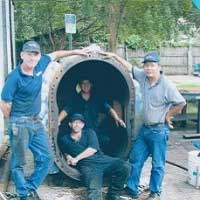What is a dry vacuum pump?

How Does a Dry Vacuum Pump Beat the Heat?
In order to counteract the heat generated, the dry vacuum pump uses a cooling jacket in its design. The absence of the cooling jacket, or any cooling mechanism, would lead to excessive heat in the unit leading to the failure of the motor.
The only fluids that are present in a dry vacuum pump are the oil reservoirs in the timing gears. To avoid leakage of any fluid of any kind, there are only microscopic clearances between the rotors and the housing.
Vapors are No Match for These Pumps
One of the best attributes of a dry vacuum pump is its ability to handle corrosive vapors as well as substances that run through the pump. The absence of any moisture prevents any corrosion from occurring in the unit.
Another attribute of a dry vacuum pump is its construction. Most often, iron is used as the basic metal for a dry vacuum pump. These pumps are not built from stainless steel or high alloy materials because of the high temperatures generated by the operation of the pump. Alloys are unable to handle the heat during operation, which often leads to breakdown of the overall structure.
As can be seen, there are some basic characteristics that define a dry vacuum pump. These include the absence of any fluids in the pump mechanism except the oil in the timing gears. The dry vacuum pump can ably manage corrosive fluids and substances because of the absence of fluids. The only drawback is the extreme temperatures generated during operation.
[/av_textblock]
Leave a Comment